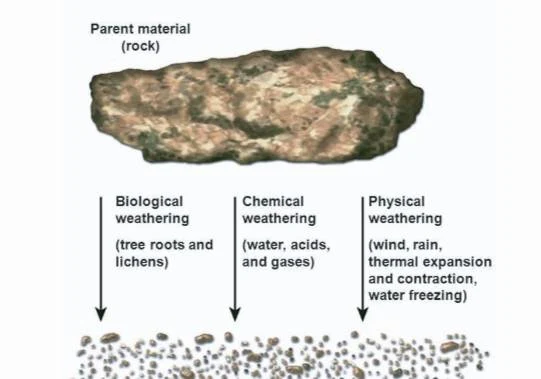Deposition can slowly add substance over a long period of time For example, stalactites and stalagmites form when rainwater enters a cave through small holes, dissolves small amounts of limestone on its way down, and deposits it before falling from the roof or landing on the floor. Over time, this deposit adds up to impressive underground structures.
 |
| Deposition In Science |
Near underwater thermal vents, boiling water that has been super heated by geological activity brings dissolved metals and sulfides. As the water cools, metallic minerals accumulate, forming dark stacks on the ocean floor.
What causes deposition?
Before deposition, material has to come from somewhere When water or wind flows over rock, soil, or any type of subsurface, the force of the moving fluid pulls some of the material away from the surface. How many and how big the particles are depends on a number of different factors.
- Speed: Faster moving fluids drag more material.
- Fluid Composition: Flowing water is generally more energetic than wind, and would make a better erosion or weathering agent.
- Material composition: Some minerals are soluble in water, so they will decompose quickly Water of a certain pH can quickly degrade certain materials.
- Temperature: Water carries heavier minerals more effectively as its temperature increases. In very cold conditions, ice can move along it.
Depositions when these particles leave the liquid and attach to a new surface This can happen through chemical action, as with limestone in water, but more often the particles fall out of suspension in the liquid. There are two main factors that determine how far particles will travel and how they will accumulate:
- Fluid motion.
- Particle size
There are three main forces acting on an individual particle in flow The first is the motion of the fluid pushing it forward, the second is the buoyant force that suspends the particles vertically, and the third is gravity. It may be easy to think of particles in a flow like a balloon lifted by a strong wind It will be carried for some distance, and a balloon is very light, but if it is filled with air, it will eventually come down.

Also, particle size and density are important Heavy materials will fall down quickly Very small and light particles can be carried in bulk, while large and heavy particles can only be rolled to the bottom. The United States Geological Survey classifies particles by size, as shown in the table below: Deposition Gas To Solid
What is the Process of Deposition?
Deposition is sediment carried by wind, running water, sea or ice Water can be transported as rocks, sand and mud or as dissolved salts in water Later organic activity can lead to salt deposition.
Wind
The term salinization describes the process by which sand grains are picked up and transported by wind Grains of sand bounce off the ground in the wind; Deposition Process When the wind stops or slows down, sand accumulates and can create sand pits.
Water
Flowing water picks up soil and rock particles When water slows down, for example when it reaches a flat surface, it begins to throw off the particles it holds It drops the largest particles first and the smaller ones as it slows down. What Is Deposition Weathering
Alluvial fans are a feature typically created when sediment carried by a mountain stream is deposited due to a rapid change in slope from a high to low gradient. When the slope angle is high, the stream flows at a high velocity and is able to transport large sediments such as rocks and sand. When the slope angle is low, the stream loses the energy needed to carry these large particles and they accumulate. The deposited material eventually spread to form an alluvial fan.
Water can also carry solutes, mostly ions that contain minerals that have dissolved from solid rock. These ions can accumulate in the ocean floor or reach the ocean and contribute to its salinity.
Sea
In coastal environments, low-energy waves deposit sediments on or near the shoreline that can no longer support their sediment load. The material carried by the ocean is washed by the water and begins to build up along the coastline, forming beaches and other coastal features such as spits and shoals. Beaches change and move through the combined action of tides, waves and currents and can lose or gain sand from season to season. From time to time the sand disappears completely, leaving behind heavy cobbles.
Ice
Glaciers are not permanent objects; They move slowly, flow under their own weight, and grow and shrink depending on climatic conditions. As they move, they carve up the landscape below, picking up sebum and rocks of all sizes. In fact, glaciers can carry the largest sedimentary boulders, sometimes reaching enormous sizes for great distances. When glaciers melt and retreat, they leave behind what are known as glacial erratic boulders, made up of rocks that have no relation to the local geology where they rested.
The typical deposit of a glacier is known so far, which is a combination of all the debris that the glacier was carrying at the time, such as clay, sand, rock and boulders. Typical glacial sediment features consist of tills known as moraines.


Comments
Post a Comment
Please do not enter any spam link in the comments box